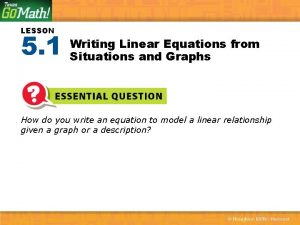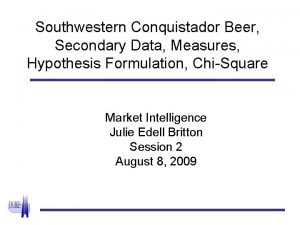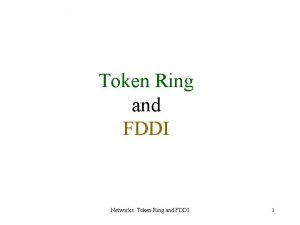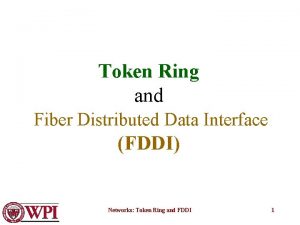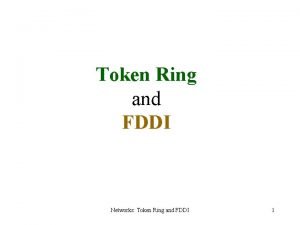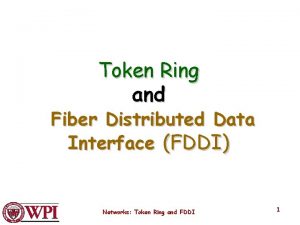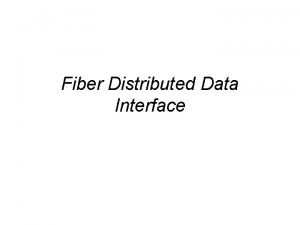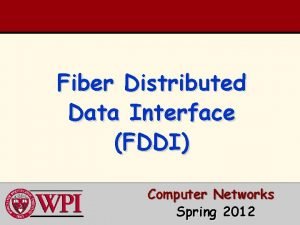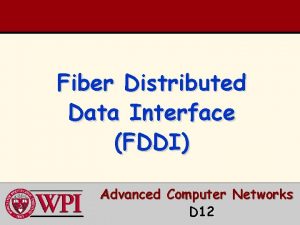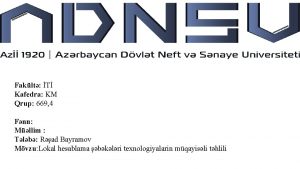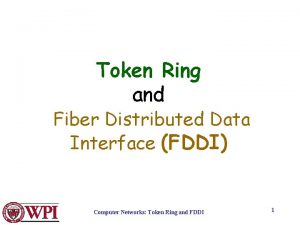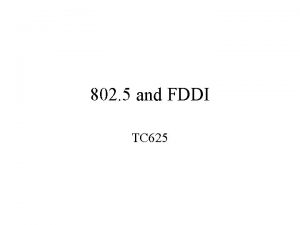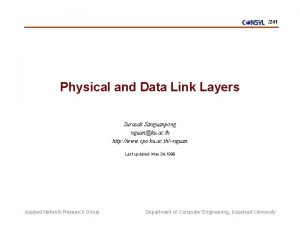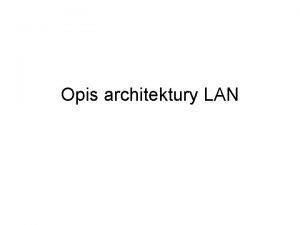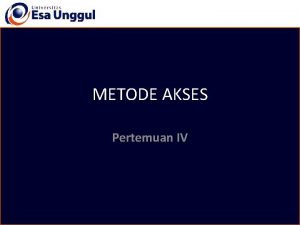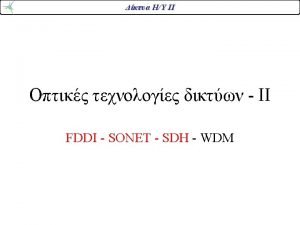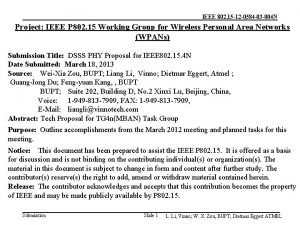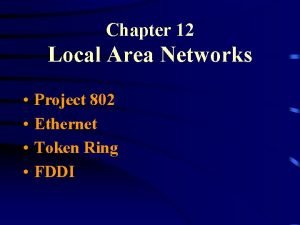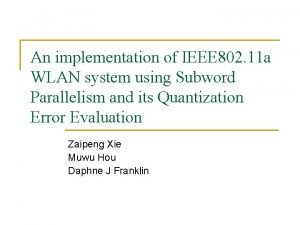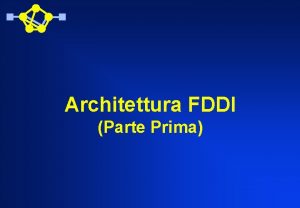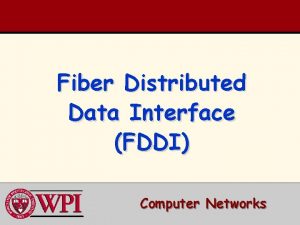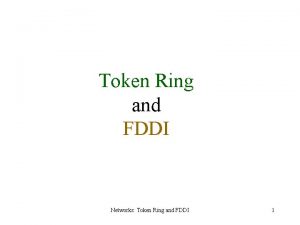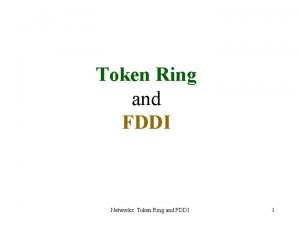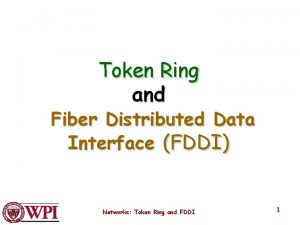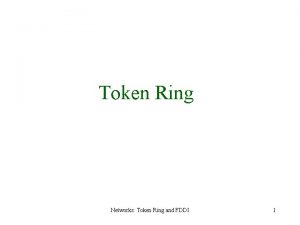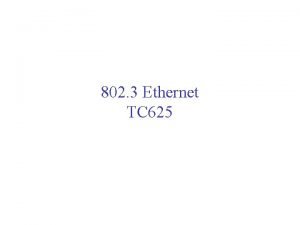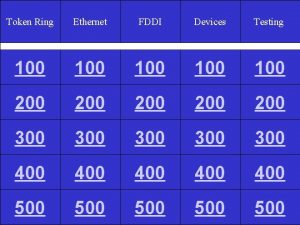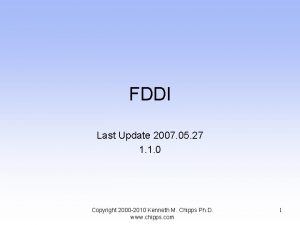802 5 and FDDI TC 625 802 5





































- Slides: 37

802. 5 and FDDI TC 625

802. 5 • • Token Ring Reference Stallings 6. 3 4/16 Mbps over STP 4 Mbps over CAT 3 UTP

History • Developed by IBM • Adopted by IEEE 802. 5 virtually unchanged from IBM implementation • Spec originally called for 4 Mbps • Upgraded to 16 Mbps in 1988 • Going to 100 Mbps in 1998? ?

Equipment • STP cable was initial standard, UTP now supported too • MAU (Multistation Access Unit) in 802. 5 is the hub that implements the ring – It’s a passive physical device that just implements the PHY • CAU (Controlled Access Unit) Intelligent MAU that interconnects LAMs • LAM (Lobe Attachment Module) interconnects 20 lobes • Each connection to the ring is called a lobe • Topology is physically a star, but is logically a ring

The Rules • You need to keep the ring withing certain physical limits – This is info for passive MAU, and type 1 cable – Equipment vendors provide platform specific info • Adjusted Ring Lengh (ARL) – Sum of all trunk cables connecting MAUs PLUS – 5 Meters for each MAU PLUS – Length of the longest lobe cable • Type 1 Cable has following limits: – 4 Mbps 390 m ARL – 16 Mbps 175 m ARL

MAC Frame SD(1) AC(1) FC(1) Destination Address (6) Source Address (6) Data (0 to 4 K on 4 Mbps or 18 K on 16 Mbps) Frame Check Sequence (4) ED(1) FS(1)

Frame Fields • SD - Starting Delimiter • AC - Access Control – Priority, Token, and Monitor – Discussed below • FC - Frame Control – Data or management frame

Frame Fields Continued • ED - End Delimiter • FS - Frame Status – Contains A & C Bits – A - Address recognized – C - Frame copied • AC = 00 Station Non-existant or inactive • AC = 10 Station there, frame not copied • AC = 11 Frame copied

Ring Operation • MAC level ring management provides following services – Maintaining the ring – Locate and isolate ring faults – Identifying hard and soft errors – Providing node status • We’ll develop each of these points in detail

Ring Maintenance • Need a way to – Initialize the ring (start token going) – Handle lost, corrupt, or permanently circulating frames and tokens • Active Monitor provides these services • One node elected Active Monitor – Monitor Contention process – Other nodes on ring act as standby monitors

Monitor Contention Process • Process to elect new Active Monitor: • Each node starts transmitting Claim Token frames – Transmit at fixed interval (10 -20 milliseconds) – Keep transmitting these until: • You receive a claim with a higher address (you lose) start passing on the higher claim token • You receive your own claim token (you win) • Strip lower address claims

Purge after the Election • After Active Monitor is elected, AM purges ring • AM uses ring purge process to reset the ring in general • AM sends Ring Purge frames every 10 -20 ms • AM stops sending the purge frames when it starts to receive them • Ring starts running when AM creates a new token and releases it

Corrupt Frames and Tokens • Permanently circulating frames – AM sets Monitor bit to 1 on all frames that pass by – If AM sees a frame where M bit is already 1, AM resets ring • Lost or corrupt frames – AM keeps a valid frame timer – If no valid frame shows up within the time limit, AM resets ring

Active Monitor Present • AM sends an Active Monitor Present frame every seven seconds • Also called “Ring Polling” • Nodes use this process to keep tabs on AM activity, and to get to know their upstream neighbor – AMP frame circulates around ring - nodes take note – Nodes then transmit Standby Monitor Present to downstream neighbor – Stops when AM gets an SMP frame – NAUN - Nearest Active Upstream Neighbor

Joining the Ring • Before joining stations do the following: – Interface self-test – Interface loopback test – Cable test - MAU loopback • Duplicate Address Test • Existing node detects new NAUN at next ring poll

Locating and Isolating Faults • Bum electrical info coming from your NAUN – Could be cable break or fault – Node transmits Beacon Frame reporting problem with NAUN – Everyone drops what they’re doing and starts repeating the beacon frame – When NAUN gets frame indicating that it is the source of problem, it removes itself from the ring… assuming it gets the beacon

Identifying Hard and Soft Errors • REM (Ring Error Monitor) is a process that runs somewhere on the ring • Detected errors are reported to the REM with a Report Soft Error Frame – – – Problems in information coming from NAUN Lost Frame Errors Congestion Errors (full buffers) Duplicate Address Errors Token Errors

Normal Ring Operation • Got traffic? – Wait until you capture the token • T=0 in AC field – Send your data in a frame with T=1 • T=1 indicates frame is data frame not token – When your data frame returns, strip frame release token

Early Token Release • • Introduced in 16 Mbps rings Release token right after sending data Improves latency Backward compatible with non-ETR stations

FDDI • • Fiber Distributed Data Interface 100 Mbps token passing ring ANSI X 3 I 9. 5 not IEEE Reference Stallings Chapter 8

Differences from 802. 5 • • • FDDI Fiber, STP, UTP 100 Mbps MTU 4500 Bytes Fault Tolerant Dual Ring • Distributed Clock • Early Release • • • 802. 5 STP, UTP 4/16 Mbps MTU 4500 -18 K Bytes No fault tolerance built into spec • Centralized Clock • Release after receive

Clock Recovery • FDDI uses distributed clock • Each station recovers clock from data stream • NRZI encoding – This fails with long strings of 0’s – Make the strings of 0’s go away – 4 B/5 B Encoding

4 B/5 B Encoding • At the PHY level, FDDI encodes traffic as 5 -bit symbols • Symbols are divided into Data, Line State, and Control – Data: 0, 1, 2, 3, 4, 5, 6, 7, 8, 9, A, B, C, D, E, F – Line State: Q, I, H – Control: J, K, L, T, R, S

More Encoding • Number of consecutive 0’s limited to three • This guarantees that you always have enough transitions to make NRZI work – 4 B/5 B NRZI gives you 80% efficiency – Line runs at 125 Mbps to give you the effective 100 Mbps – 802. 5 uses Manchester which requires 2 x base rate or 50% efficiency

Fiber Distributed Data Interface • FDDI is a token ring network designed for reliable LAN or WAN use • 100 Mbps data transfer rate using fiber optic cable or UTP Media type fiber optic UTP 100 m Segment length Signaling 2 km 4 B 5 B+NRZI MLT-3 • Up to 500 stations; up to 100 km! FDDI has 2 rings oriented in opposite directions. In normal operation only one ring is used. Token or Data frame circulates ring. Each station buffers 9 -80 bits.

Dual Ring Operation If cable or a node is Under normal conditions only one ring damaged, the second cable is used to re-establish the is used. loop. Link down

Station Attachment Dual Attachment Stations (DAS): nodes attached to both rings, as in the previous slide. A DAS interface includes circuitry to use either ring for input and output. Single Attachment Stations (SAS): a node may be attached to only one ring, via a concentrator, to reduce interface cost. The concentrator contains an optical bypass to remove SAS node if it fails. Concentrator (DAS) Upstream neighbor SAS SAS

Operation Early Token Release: Destination host copies the sender generates a new frame and sets 2 bits in the token as soon as he finishes trailer, but doesn’t remove sending his frame. Since frame from the network. FDDI rings can be up to 100 km, this is. Token needed to achieve good utilization. destination copies frame

Early Release Improves Throughput Another station can seize Second station also the token and insert his own frame after the first sender’s frame. A releases token early, so other stations can transmit (tailgate), too. A B

FDDI Ring Size and Latency An FDDI ring can be up to 100 km long. The ring latency is a significant factor on large rings. Each station buffers 9 - 80 bits of a frame at it passes by, but may retransmit bits before its buffer is full. Suppose each node buffers 5 bits on average. Delay in node = 5/100 Mbps = 50 ns Propagation delay in 1 km cable is: 1 km/0. 67 c = 5 microseconds/km For a network with 40 nodes and 10 km of cable the ring latency is:

FDDI Ring Problems What happens if a sender crashes while his own frame is still traversing the network? What happens is the token is lost or damaged? en k To

FDDI Frame Formats Token Frame 8 byte Sync 1 byte Start delimiter 1 Frame control 1 End delimiter Data Frame Sync 1 byte Start delimiter 1 Frame control 6 Dest. address 6 Source address 0 - 4480 Data Same address format as ethernet bits: 1 4 1 2 No min. length; C L FT TYPE no bit stuffing C = class: synchronous or asynchronous L = address length (16 or 48 bit) FT = frame type TYPE = for a control frame, the control type 4 Frame CRC 1 End delimiter 1 Frame status “error detected” bit Two bits for address recognized and frame copied (receiver sets(

“Synchronous” Frames • Synchronous frames are designed to support delay sensitive traffic, particularly voice • Synchronous frames are small: up to 96 bytes of circuit switched data, 16 bytes of non-circuit switched data • Multiple stations may acquire a time slot (or slots) in the same synchronous frame. Once acquired, a station receives the same time slot in every synchronous frame of this series until it explicitly releases it -- guaranteed bandwidth • Synchronous frame generation doesn’t wait for token A designated station generates synchronous frames @ 8000/sec (125 msec), as needed for PCM transmission of voice.

Asynchronous Frames • Asynchronous frames are normal data frames, which can contain up to 4, 500 bytes of data. • A station must wait for token before sending an asynchronous frame. • The amount of data a station can send it limited by a maximum Token Holding Time (THT), which is determined by how “late” or “early” the token arrives. • When token arrives, the measured Token Rotation Time (TRT) is compared with an agreed upon Target Token Rotation Time (TTRT) to determine if station can send any asynchronous frames.

Token Rotation Time An FDDI ring may contain 500 stations 500 x Transmission. Time + Ring. Latency 500 =x (1000 x 8 / 100 Mb/s) + (100, 000 m / 0. 65 c( 40 =msec Too slow!! 2# 0# Token. Rotation. Time = 50 and 100 km of fiber optic cable. Suppose that each station grabs the token and transmits a 1000 byte frame. The time for the token to come back to node #1 is: 1# 1, 000 bytes

Target Token Rotation Time To limit the Token Rotation Time (TRT), the stations agree on a Target Token Rotation Time (TTRT. ( The TTRT and observed TRT determine how long a station can transmit, called the Token Holding Time (THT. ( A station also keeps track of the time it uses sending synchronous data, called its synchronous allocation (SA. ( When a token arrives, the station checks: TRT + SA > TTRT? If TRT+SA > TTRT then the station doesn’t send any asynchronous frames. If TRT+SA < TTRT, then the station may transmit data for a time up to THT = TTRT - SA

SMT • Station management • Provides for: – Connection Initialization – Find neighbors, test link – Topology Control – Enforce FDDI topology rules – Ring Initialization – Create token and get it spinning – Parameter Setting – Timer
 Bridges from 802.x to 802.y
Bridges from 802.x to 802.y Bridges from 802.x to 802.y
Bridges from 802.x to 802.y Lhb 625
Lhb 625 Lesson 5-1 writing linear equations
Lesson 5-1 writing linear equations 625 s president st baltimore md 21202
625 s president st baltimore md 21202 367 562 rounded to the nearest 100 000
367 562 rounded to the nearest 100 000 271 rounded to the nearest hundred
271 rounded to the nearest hundred 625/100 in simplest form
625/100 in simplest form 23 cfr 625
23 cfr 625 Jihlavská 20, 625 00 brno
Jihlavská 20, 625 00 brno 625/2
625/2 Hasil dari 0 625 per 0 875 adalah
Hasil dari 0 625 per 0 875 adalah 4225-625
4225-625 What is fddi
What is fddi Fddi ring
Fddi ring Fddi uses
Fddi uses Fddi token ring
Fddi token ring Fddi in computer network
Fddi in computer network Fddi frame format
Fddi frame format Fddi frame format
Fddi frame format Fddi vs token ring
Fddi vs token ring Fddi texnologiyasi
Fddi texnologiyasi Fddi vs ethernet
Fddi vs ethernet Fddi frame format
Fddi frame format Fddi ring
Fddi ring Fddi ring
Fddi ring Rede token ring
Rede token ring Fddi topologia
Fddi topologia Fddi adalah
Fddi adalah Topology.ppt free download
Topology.ppt free download Fddi adalah
Fddi adalah What is fddi
What is fddi Mac address
Mac address 802 15
802 15 Estandares ieee 802
Estandares ieee 802 Project 802
Project 802 Bluetooth ieee 802
Bluetooth ieee 802 Wlan 802
Wlan 802



